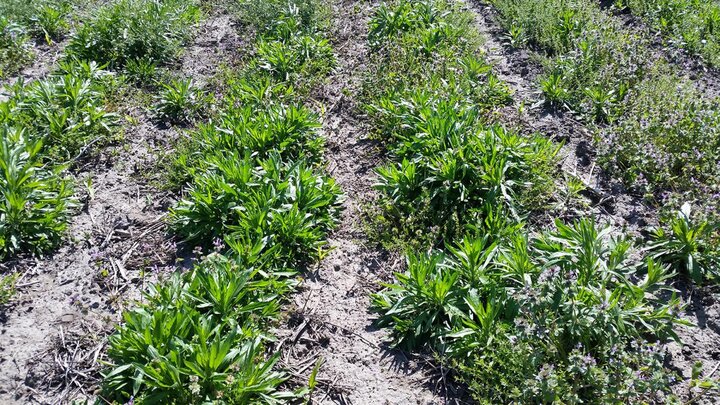Glyphosate-resistant marestail has infested about 2.2 million acres in Nebraska (Figure 1). Marestail is difficult to control due to its emergence pattern. Marestail primarily emerges in the fall though some will emerge from late March through early June, easily escaping herbicide applications and making it difficult to control.
This is the time of year when fall-emerged marestail starts bolting (stem elongation) (Figure 2) and is more easily seen infesting corn (Figure 3) and soybean fields in Nebraska. Ideally, the best time to control marestail is in the fall or early spring when marestail plants are young and actively growing (rosette stage) before corn and soybean planting.
With the cycling of cool-wet and hot-dry weather this spring and multiple rains over the last 10 days, early spring burndown and pre-emergence herbicide application for control of marestail have been less effective. Even in fields where 2,4-D and/or other burndown herbicides were applied for control of glyphosate-resistant marestail, wet cloudy weather has reduced the efficacy of these herbicides. This has resulted in marestail control escapes from early burndown herbicides. Additionally, due to continuous rain, corn and soybean planting were delayed in many fields, providing an extended opportunity for marestail growth and establishment.
Even after planting, many corn and soybean fields may have been too wet for a pre-emergence herbicide application. As a result, postemergence herbicides are the only option for control of marestail. Glyphosate applied alone will not be effective for control of glyphosate-resistant marestail in glyphosate-resistant corn and soybean (Figure 4); however, there are several postemergence herbicide options for corn and a limited number for soybean.
Control in Corn
For postemergence control of glyphosate-resistant marestail in corn, dicamba, Liberty® (only for Liberty Link Corn®), and atrazine are effective options. Atrazine applied alone will not control larger marestail plants. Control options for marestail in corn include:
- DiFlexx is a new formulation of dicamba with CSI safener. It can be applied at a rate of 10 to 12 fl oz/acre up to V10 corn. It will provide better corn safety.
- Diflexx DUO is a premix of DiFlexx and Laudis and can provide effective control of marestail.
- Status is a premix of dicamba and diflufenzopyr and can be applied to corn up to 36 inches tall or V10 stage. It may provide about 80% control, depending on size of marestail.
- Clarity can be applied up to 16 oz/acre. Apply broadcast up to the 5-leaf stage or 8-inch corn. Apply 8 oz/acre or less broadcast or as a directed spray up to 36 inches tall or 15 days before tassel emergence, whichever occurs first.
- Corn more than about 8 inches tall is more sensitive to dicamba, but use of a directed spray will reduce the risk of injury.
- Liberty can be applied only to Liberty Link corn. It is a contact herbicide, so effective spray coverage is required. (Use a spray volume of more than 15 gallons per acre and medium size spray droplets). Liberty can be tank-mixed with DiFlexx to improve marestail control in Liberty Link corn.
- Hornet is a combination of clopyralid and flumetsulam. It can provide up to 80% control, depending on size of marestail.
- Acuron or Resicore can be applied early postemergence when corn is less than 12 inches tall. Some other herbicides such as Realm Q or Capreno + atrazine also can be considered.



Control in Soybean
Effective postemergence herbicides are very limited in soybean for control of glyphosate-resistant marestail.
- FirstRate can provide about 60-80% control, depending on height of marestail at the time of application.
- Reflex, Flexstar, Harmony SG, Marvel, and Torment also may be good options.
- If Liberty Link soybean is planted, a postemergence application of Liberty may be effective; however, Liberty can only be applied before Liberty Link soybean start flowering. Also, follow application recommendations listed above for greater efficacy.
- XtendiMax or Engenia can be applied in Roundup Ready 2 Xtend soybean. Specific nozzle and tank-mixing instructions should be followed and are available for XtendiMax at http://xtendimaxapplicationrequirements.com and Engenia at www.EngeniaTankMix.com
For other herbicide options, refer to 2017 Guide for Weed, Disease, and Insect Management in Nebraska (EC 130).
Always read the herbicide label before applying in the field.

